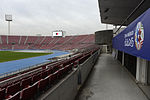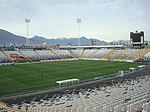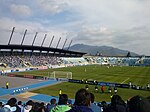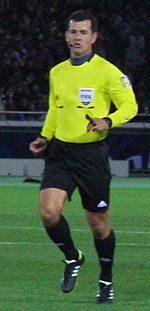2015 Copa América: Difference between revisions
Eh Oh Canada (talk | contribs) |
→Group B: update Arg-Par score |
||
| Line 259: | Line 259: | ||
|align=right|{{fb-rt|URU}}||align=center|[[2015 Copa América Group B#Uruguay vs Jamaica|1–0]]||{{fb|JAM}}|| [[Estadio Regional de Antofagasta]], [[Antofagasta]] |
|align=right|{{fb-rt|URU}}||align=center|[[2015 Copa América Group B#Uruguay vs Jamaica|1–0]]||{{fb|JAM}}|| [[Estadio Regional de Antofagasta]], [[Antofagasta]] |
||
|- style=font-size:90% |
|- style=font-size:90% |
||
|align=right|{{fb-rt|ARG}}||align=center|[[2015 Copa América Group B#Argentina vs Paraguay| |
|align=right|{{fb-rt|ARG}}||align=center|[[2015 Copa América Group B#Argentina vs Paraguay|2–1]]||{{fb|PAR}}|| [[Estadio La Portada]], [[La Serena]] |
||
|- |
|- |
||
|16 June 2015 |
|16 June 2015 |
||
Revision as of 23:20, 13 June 2015
| Copa América Chile 2015 | |
|---|---|
| File:Copa-America-2015.svg | |
| Tournament details | |
| Host country | Chile |
| Dates | 11 June – 4 July 2015 |
| Teams | 12 (from 2 confederations) |
| Venue(s) | 9 (in 8 host cities) |
| Tournament statistics | |
| Matches played | 3 |
| Goals scored | 3 (1 per match) |
| Top scorer(s) | (1 goal each) |
The 2015 Copa América is the 44th edition of the Copa América, the main international football tournament for national teams in South America, and currently taking place in Chile between the dates of 11 June to 4 July 2015.[1] The competition will be organized by CONMEBOL, South America's football governing body.
Uruguay are the defending champions. Twelve teams will compete, the ten members of CONMEBOL and two guests from CONCACAF – Mexico and Jamaica, the latter of which will compete in Copa América for the first time. The winner of the tournament, or the best placed CONMEBOL team if Mexico or Jamaica win the tournament, will qualify for the 2017 FIFA Confederations Cup.
Host country
Originally, it was to be hosted by Brazil, as suggested by the Brazilian Football Confederation (CBF) in February 2011[2] due to CONMEBOL's rotation policy of tournaments being held in alphabetical order. However, due to the organization of the 2013 FIFA Confederations Cup, 2014 FIFA World Cup and the 2016 Summer Olympics in that country, Brazil decided against also hosting the Copa América. CONMEBOL’s president Nicolas Leoz had mentioned the possibility of the tournament being organized in Mexico (despite this country not being a member of CONMEBOL) as part of the federation's centenary celebrations.[3] Brazil and Chile's Football Federations discussed the idea of swapping around the order of being hosts of the 2015 and 2019 tournaments.[4] The swap was made official in May 2012.[5]
Venues
There will be nine different stadiums in eight cities used for the tournament. Most stadiums are in renovation or rebuilding stages.
| Antofagasta |
2015 Copa América (Chile) |
La Serena | |
|---|---|---|---|
| Estadio Regional de Antofagasta | Estadio La Portada | ||
| Capacity: 21,178 | Capacity: 17,194 | ||
 |
File:La Portada La Serena.jpg | ||
| Viña del Mar | Valparaíso | ||
| Estadio Sausalito | Estadio Elías Figueroa | ||
| Capacity: 22,340 | Capacity: 20,575 | ||
 (Old stadium) |

| ||
| Santiago | Rancagua | ||
| Estadio Nacional | Estadio Monumental David Arellano | Estadio El Teniente | |
| Capacity: 48,665 | Capacity: 47,347 | Capacity: 15,252 | |
 |
 |

| |
| Concepción | Temuco | ||
| Estadio Municipal de Concepción | Estadio Municipal Germán Becker | ||
| Capacity: 30,448 | Capacity: 18,936 | ||
 |

| ||
Teams

Mexico and Japan were initially invited to join the 10 CONMEBOL nations in the tournament.[6][7] Japan declined the invitation, and China was invited instead,[8][9][10] but later withdrew due to the 2018 FIFA World Cup qualification (AFC) being held at the same time.[11][12] In May 2014, it was announced that the Jamaica Football Federation had accepted an invitation to participate.[13]
Draw
The draw of the tournament was originally to be held on 27 October 2014 in Viña del Mar,[14] but was postponed to 24 November.[15] The 12 teams were drawn into three groups of four.[16]
CONMEBOL announced the composition of the four pots on 10 November 2014.[17][18] Pot 1 contained the hosts Chile (which has been automatically assigned to position A1), together with Argentina and Brazil. The remaining nine teams were allocated to the other three pots according to their FIFA World Rankings as of 23 October 2014 (shown in brackets). On 23 November 2014, it was revealed by CONMEBOL that Argentina and Brazil had been assigned to positions B1 and C1, respectively.[19]
| Pot 1 | Pot 2 | Pot 3 | Pot 4 |
|---|---|---|---|
Squads
Each country had a final squad of 23 players (three of whom had to be goalkeepers) which had to be submitted before the deadline of 1 June 2015.[20]
The 2015 UEFA Champions League Final date of 6 June caused problems for South American players for Barcelona and Juventus. FIFA international rules require clubs to release players 14 days prior to the start of an international tournament, but the players featured in the final, leaving them at most five days to acclimate.[21]
Uruguayan forward Luis Suárez was suspended for the whole tournament, as he served a nine-match ban in international football for biting Italian defender Giorgio Chiellini during Uruguay's final group stage match against Italy in the 2014 FIFA World Cup.[22]
Match officials

Source:[23]
| Confederation | Referee | Assistant referees | Matches refereed |
|---|---|---|---|
| CONMEBOL | Néstor Pitana (ARG) | Hernan Maidana (ARG) Juan Pablo Belatti (ARG) |
Chile vs Ecuador (Group A) |
| Raúl Orosco (BOL) | Javier Bustillos (BOL) Juan P. Montaño (BOL) |
||
| Sandro Ricci (BRA) | Emerson De Carvalho (BRA) Fabio Pereira (BRA) |
||
| Enrique Osses (CHI) Jorge Osorio (CHI) Julio Bascuñán (CHI) |
Carlos Astroza (CHI) Marcelo Barraza (CHI) Raúl Orellana (CHI) |
||
| Wilmar Roldán (COL) | Alexander Guzmán (COL) Cristian De La Cruz (COL) |
||
| Carlos Vera (ECU) | Christian Lescano (ECU) Byron Romero (ECU) |
||
| Enrique Cáceres (PAR) | Rodney Aquino (PAR) Carlos Cáceres (PAR) |
Mexico vs Bolivia (Group A) | |
| Víctor Hugo Carrillo (PER) | César Escano (PER) Johnny Bossio (PER) |
||
| Andrés Cunha (URU) | Mauricio Espinosa (URU) Carlos Pastorino (URU) |
||
| José Argote (VEN) | Jorge Urrego (VEN) Jairo Romero (VEN) |
Uruguay vs Jamaica (Group B) | |
| CONCACAF | Joel Aguilar (SLV) | Garnet Page (JAM) Ricardo Morgan (JAM) |
|
| Roberto García Orozco (MEX) | José Luis Camargo (MEX) Marvin Torrentera (MEX) |
Group stage
The fixture schedule was announced on 11 November 2014.[24]
The first round, or group stage, saw the twelve teams divided into three groups of four teams. Each group was a round-robin of six games, where each team played one match against each of the other teams in the same group. Teams were awarded three points for a win, one point for a draw and none for a defeat. The teams finishing first, second and two best-placed third teams in each group qualified for the Quarter-finals.
- Tie-breaking criteria
Teams were ranked on the following criteria:[20]
- Greater number of points in all group matches
- Goal difference in all group matches
- Greater number of goals scored in all group matches
- Head-to-head result (between two teams only)
- Penalty shoot-out (between two teams playing last round of matches only)
- Drawing of lots by the CONMEBOL Organising Committee
All times local, CLT (UTC−3).[25]
Group A
| Pos | Team | Pld | W | D | L | GF | GA | GD | Pts | Qualification |
|---|---|---|---|---|---|---|---|---|---|---|
| 1 | 3 | 2 | 1 | 0 | 10 | 3 | +7 | 7 | Advance to knockout stage | |
| 2 | 3 | 1 | 1 | 1 | 3 | 7 | −4 | 4 | ||
| 3 | 3 | 1 | 0 | 2 | 4 | 6 | −2 | 3 | ||
| 4 | 3 | 0 | 2 | 1 | 4 | 5 | −1 | 2 |
| 11 June 2015 | |||
| Chile |
2–0 | Estadio Nacional, Santiago | |
| 12 June 2015 | |||
| Mexico |
0–0 | Estadio Sausalito, Viña del Mar | |
| 15 June 2015 | |||
| Ecuador |
Match 7 | Estadio Elías Figueroa, Valparaíso | |
| Chile |
Match 8 | Estadio Nacional, Santiago | |
| 19 June 2015 | |||
| Mexico |
Match 13 | Estadio El Teniente, Rancagua | |
| Chile |
Match 14 | Estadio Nacional, Santiago |
Group B
| Pos | Team | Pld | W | D | L | GF | GA | GD | Pts | Qualification |
|---|---|---|---|---|---|---|---|---|---|---|
| 1 | 3 | 2 | 1 | 0 | 4 | 2 | +2 | 7 | Advance to knockout stage | |
| 2 | 3 | 1 | 2 | 0 | 4 | 3 | +1 | 5 | ||
| 3 | 3 | 1 | 1 | 1 | 2 | 2 | 0 | 4 | ||
| 4 | 3 | 0 | 0 | 3 | 0 | 3 | −3 | 0 |
Group C
| Pos | Team | Pld | W | D | L | GF | GA | GD | Pts | Qualification |
|---|---|---|---|---|---|---|---|---|---|---|
| 1 | 3 | 2 | 0 | 1 | 4 | 3 | +1 | 6 | Advance to knockout stage | |
| 2 | 3 | 1 | 1 | 1 | 2 | 2 | 0 | 4 | ||
| 3 | 3 | 1 | 1 | 1 | 1 | 1 | 0 | 4 | ||
| 4 | 3 | 1 | 0 | 2 | 2 | 3 | −1 | 3 |
| 14 June 2015 | |||
| Colombia |
Match 5 | Estadio El Teniente, Rancagua | |
| Brazil |
Match 6 | Estadio Municipal Germán Becker, Temuco | |
| 17 June 2015 | |||
| Brazil |
Match 11 | Estadio Monumental David Arellano, Santiago | |
| 18 June 2015 | |||
| Peru |
Match 12 | Estadio Elías Figueroa, Valparaíso | |
| 21 June 2015 | |||
| Colombia |
Match 17 | Estadio Municipal Germán Becker, Temuco | |
| Brazil |
Match 18 | Estadio Monumental David Arellano, Santiago |
Ranking of third placed teams
| Pos | Grp | Team | Pld | W | D | L | GF | GA | GD | Pts | Qualification |
|---|---|---|---|---|---|---|---|---|---|---|---|
| 1 | A | 1 | 0 | 1 | 0 | 0 | 0 | 0 | 1 | Advance to knockout stage | |
| 2 | B | 3rd Place Group B | 0 | 0 | 0 | 0 | 0 | 0 | 0 | 0 | |
| 3 | C | 3rd Place Group C | 0 | 0 | 0 | 0 | 0 | 0 | 0 | 0 |
Rules for classification: 1) points in all group matches; 2) total goal differential; 3) total goals scored; 4) lots drawn by CONMEBOL.[20]
Knockout stage
In the knockout stage, the eight teams play a single-elimination tournament, with the following rules:[20]
- In the quarterfinals, semifinals, and third place playoff, if tied after 90 minutes, the penalty shoot-out is used to determine the winner (no extra time is played).
- In the final, if tied after 90 minutes, 30 minutes of extra time is played. If still tied after extra time, the penalty shoot-out is used to determine the winner.
In the knockout stage, the eight teams played a single-elimination tournament, with the following rules:[20]
- In the quarter-finals, teams from the same group could not play each other.
- In the quarter-finals, semi-finals, and third place playoff, if tied after 90 minutes, a penalty shoot-out was used to determine the winner (no extra time was played).
- In the final, if tied after 90 minutes, 30 minutes of extra time were played. If still tied after extra time, a penalty shoot-out was used to determine the winner.
| Quarter-finals | Semi-finals | Final | ||||||||
| 24 June – Santiago | ||||||||||
| 1 | ||||||||||
| 29 June – Santiago | ||||||||||
| 0 | ||||||||||
| 2 | ||||||||||
| 25 June – Temuco | ||||||||||
| 1 | ||||||||||
| 1 | ||||||||||
| 4 July – Santiago | ||||||||||
| 3 | ||||||||||
| 0 (4) | ||||||||||
| 26 June – Viña del Mar | ||||||||||
| 0 (1) | ||||||||||
| 0 (5) | ||||||||||
| 30 June – Concepción | ||||||||||
| 0 (4) | ||||||||||
| 6 | ||||||||||
| 27 June – Concepción | ||||||||||
| 1 | Third place play-off | |||||||||
| 1 (3) | ||||||||||
| 3 July – Concepción | ||||||||||
| 1 (4) | ||||||||||
| 2 | ||||||||||
| 0 | ||||||||||
Quarter-finals
Semi-finals
Third place playoff
Final
Goal scorers
Players denoted in bold are still active in the tournament.
- 1 goal
Source: CONMEBOL.com[26]
Broadcasting rights
| Country | Broadcaster | Notes |
|---|---|---|
| Xbox Live, YouTube [citation needed] | Live streaming all matches of Copa América. Blocked in certain territories including the UK. Xbox Live stream available via various third party apps (e.g. Sling TV app in the United States[27]). | |
| beIN Sports Arabia[28] | ||
| DirecTV Sports, ESPN | DirecTV broadcast live all matches of Copa America. ESPN broadcast highlights. | |
| TyC Sports, TV Pública | All matches live on TyC Sports. Some matches Live on TV Pública. | |
| Bolivia TV , Cotas Cable TV, Tigo Star | Bolivia TV will only broadcast Bolivia matches. Cotas Cable TV, Tigo Star and others with license from Sport Tv Rights will broadcast all matches. | |
| Arena Sport | ||
| Rede Globo, SporTV | Rede Globo will only broadcast Brazil matches. SporTV will broadcast all matches. | |
| beIN Sports Canada, Radio-Canada | Radio Broadcast on Radio One. | |
| Canal 13 and TVN | Broadcast live on Canal 13 and TVN with all matches. | |
| LeTV | All matches live. | |
| Caracol Televisión | Broadcast live on Caracol Television with all matches. | |
| Arenasport | All matches live. | |
| Sport 1/2[29] | ||
| Gama TV and TC Televisión | All matches live on Gama TV and TC Televisión. | |
| beIN Sports | All matches live.[30] | |
| Skai TV | All matches live. | |
| R-Media, Canal 11 (Honduras) | ||
| MSM | Broadcast live on Sony SIX and Sony KIX. | |
| Kompas TV | ||
| IRIB 3 - IRIB Varzesh - IRIB HD | ||
| Setanta Sports[31] | All matches live. | |
| Sport 5 | ||
| Gazzetta TV[32] | All matches live | |
| CVM TV, Sportsmax | CVM TV(free-to-air) will broadcast Jamaica's matches only. Sportsmax(cable channel) will broadcast all matches except those involving Jamaica. | |
| NHK | ||
| RTK | All matches live on RTK. | |
| Arena Sport | ||
| Media Prima, Astro | ||
| Televisa, TV Azteca | ||
| Arena Sport | ||
| Sport 1[33] | All matches live. | |
| Tigo Sports and Telefuturo | All matches live on Tigo Sports. Some matches live on Telefuturo. | |
| América Televisión | All the matches live.[34]
Radio broadcast on Du Pont's Radio and RPP (All the matches live). | |
| ABS-CBN Corporation | ||
| TVP | All matches Live on TVP Sport and sport.tvp.pl(region blocked), some matches on TVP 1. | |
| TVI | Eight matches live on TVI (including the final). The remaining on TVI24. | |
| Digi Sport[35] | ||
| Arena Sport | ||
| StarHub TV | ||
| Sport 1/2[29] | ||
| Šport TV (Slovenia) | ||
| Canal+ Liga | ||
| China Television | All matches live on CTV. | |
| Channel 3 | ||
| Tivibuspor[36] | ||
| beIN Sports[28] | Radio broadcast on Futbol de Primera. | |
| Premier Sports[37] | Exclusive coverage of all 26 matches via SKY, Virgin, TalkTalk and the Premier Player. | |
| Channel 10, Teledoce | Broadcast live on Equital's Pay TV with all matches. Some matches Live on Teledoce and C10. | |
| Venevisión, DirecTV Sports | ||
| SCTV | Broadcast live on SCTV's cable network with all matches. |
Marketing
Match Ball
On 16 November 2014, the Official Match Ball [OMB] was unveiled at the Estadio Nacional. The name of the ball is Nike Cachaña, which is a Chilean slang term for a successful feint or dribble. During its launch, the Chilean international Arturo Vidal was present. The ball is mainly designed with white as main appearance featured with blue and red applications, representing host nation Chile. The colors of Chilean flag make a statement in the design of this ball: the red representing the people, the blue symbolizing the Chilean sky, and the white for the Andes that so strongly define the geography of this country.[38]
Mascot
The official mascot of the tournament, a young culpeo fox, was unveiled on 17 November 2014.[39] The name of the mascot, "Zincha", was chosen by the public over two other options, "Andi" and "Kul".[40]
Official song
"Al Sur del Mundo" by Chilean group La Noche de Brujas will serve as the official song of the tournament. It will be performed during the opening ceremony of the competition on 11 June. It features the different cultures of the twelve competing nations.[41]
References
- ^ "The Copa América Chile-2015 will be held from June 11 to July 4". CONMEBOL.com. 12 February 2014.
- ^ Copa América será no Brasil em 2015, confirma CBF em seminário (in Portuguese)
- ^ Conmebol quiere la Copa América 2015 en México sobre Chile
- ^ La Copa América da otro paso hacia Chile
- ^ "Es oficial: la Copa América 2015 será en Chile". conmebol.com (in Spanish). CONMEBOL. 10 May 2012. Retrieved 20 May 2012.
{{cite web}}: Unknown parameter|trans_title=ignored (|trans-title=suggested) (help) - ^ "Reunión de Presidentes y el C. Ejecutivo". CONMEBOL.com. 24 October 2012.
- ^ "México y Japón serán las invitadas a la Copa América 2015". sdpnoticias.com. 13 February 2014.
- ^ "China to enter 2015 Copa America in Chile". wildeastfootball.net. 2 March 2014.
- ^ "China accept 2015 Copa America invitation". tribalfootball.com. 3 March 2014.
- ^ "China agree to enter 2015 Copa America". Global Times. 3 March 2014.
- ^ "遗憾!赛程撞车,足协忍痛放弃美洲杯". Hupu.com. 16 April 2014.
- ^ [http://bbs.hupu.com/9330694.html "足协正式拒绝美洲杯:冲世界杯���紧"]. Hupu.com. 19 April 2014.
{{cite web}}: replacement character in|title=at position 15 (help) - ^ "Jamaica to tackle Copa America". rjrnewsonline. 24 May 2014. Retrieved 24 May 2014.
- ^ "Sorteo de la Copa América 2015 se realizará en octubre en Viña del Mar" (in Spanish). biobiochile.cl. 19 February 2014.
{{cite web}}: Unknown parameter|trans_title=ignored (|trans-title=suggested) (help) - ^ "Copa América Chile 2015: la ceremonia del sorteo se realizará el 24 de noviembre" (in Spanish). CONMEBOL.com. 26 August 2014.
{{cite web}}: Unknown parameter|trans_title=ignored (|trans-title=suggested) (help) - ^ "Argentina paired with Uruguay in Copa América draw as Brazil face Colombia". Copa América 2015. 24 November 2014.
- ^ "La Copa América Chile 2015 tiene a sus cabezas de serie: la anfitriona, Argentina y Brasil" (in Spanish). CONMEBOL.com. 10 November 2014.
{{cite web}}: Unknown parameter|trans_title=ignored (|trans-title=suggested) (help) - ^ "Viña del Mar hosts draw for 2015 Copa América". Copa América Chile 2015. 11 November 2014.
- ^ "Conmebol fijó los grupos de los cabezas de serie para la Copa" (in Spanish). CONMEBOL.com. 23 November 2014.
{{cite web}}: Unknown parameter|trans_title=ignored (|trans-title=suggested) (help) - ^ a b c d e "Reglamento Copa América - Chile 2015" (PDF). CONMEBOL.com.
- ^ Pérez Serrano, Ángel (28 July 2014). "La Copa América, pesadilla del Barça este año" (in Spanish). mundodeportivo.com. Retrieved 11 February 2015.
{{cite web}}: Unknown parameter|trans_title=ignored (|trans-title=suggested) (help) - ^ "FIFA statement on CAS decision relating to Luis Suarez". FIFA. Retrieved 14 August 2014.
- ^ "The 39 referees of the Copa América - Chile 2015". CONMEBOL. 23 May 2015. Retrieved 24 May 2015.
- ^ "Copa América fixture list announced for Chile 2015". Ca2015.com.com. 11 November 2014. Retrieved 16 November 2014.
- ^ "Programa oficial del acontecimiento que cada vez está más cerca... La Copa América Chile 2015". CONMEBOL.com. 25 April 2015.
- ^ "Copa America Chile 2015 — Goleadores". CONMEBOL.com.
- ^ https://m.facebook.com/story.php?story_fbid=1767834893443041&id=1639268889632976
- ^ a b "2015 Copa America". beinsports.tv.
- ^ a b "Startuje Copa América na Sport1 HD a Sport2 HD" [Copa América starts at Sport1 HD and HD Sport2]. Sport1 TV (in Czech).
- ^ "MCS and beIN Media Group snap up Latin American football rights". Sportbusiness.com. 16 January 2015.
- ^ http://www.setanta.com/ie/big-summer-of-sport-on-setanta/
- ^ http://www.gazzetta.it/Calcio/Campionati-Esteri/05-06-2015/copa-america-show-11-giugno-diretta-esclusiva-gazzettatv-canale-59-dtt-12043221386.shtml
- ^ Copa America uiteraard live bij sport 1 , Copa America will be broadcast live by Sport 1
- ^ "America TV compra los derechos de las próximas tres Copa América (In Spanish)". elcomercio.pe.
- ^ http://www.digisport.ro/Sport/FOTBAL/Spectacolul+Americii+de+Sud+se+vede+si+in+Romania+Copa+America+v
- ^ https://twitter.com/tivibuspor/status/605292635134283776
- ^ "2015 Copa America TV Schedule UK". WherestheMatch.com. 14 May 2015. Retrieved 14 May 2015.
- ^ "Nike Cachana – Copa America 2015 Ball Revealed". Footballwood. Retrieved 14 March 2015.
- ^ "Official mascot for the 2015 Copa América revealed - now help choose a name!". Copa América Chile 2015. 17 November 2014.
- ^ "Zincha - 2015 Copa América mascot now has a name #BienvenidoZincha". Copa América Chile 2015. 28 November 2014.
- ^ "Al Sur Del Mundo – The Official Theme Song of Copa America 2015". Copaamerica.Footballwood. Retrieved 19 May 2015.
External links
- Copa América Chile 2015 (Official website) Template:En icon
- Copa América 2015, CONMEBOL.com Template:Es icon
- Copa América 2015, FOOTBALLLENS.com Template:En icon

